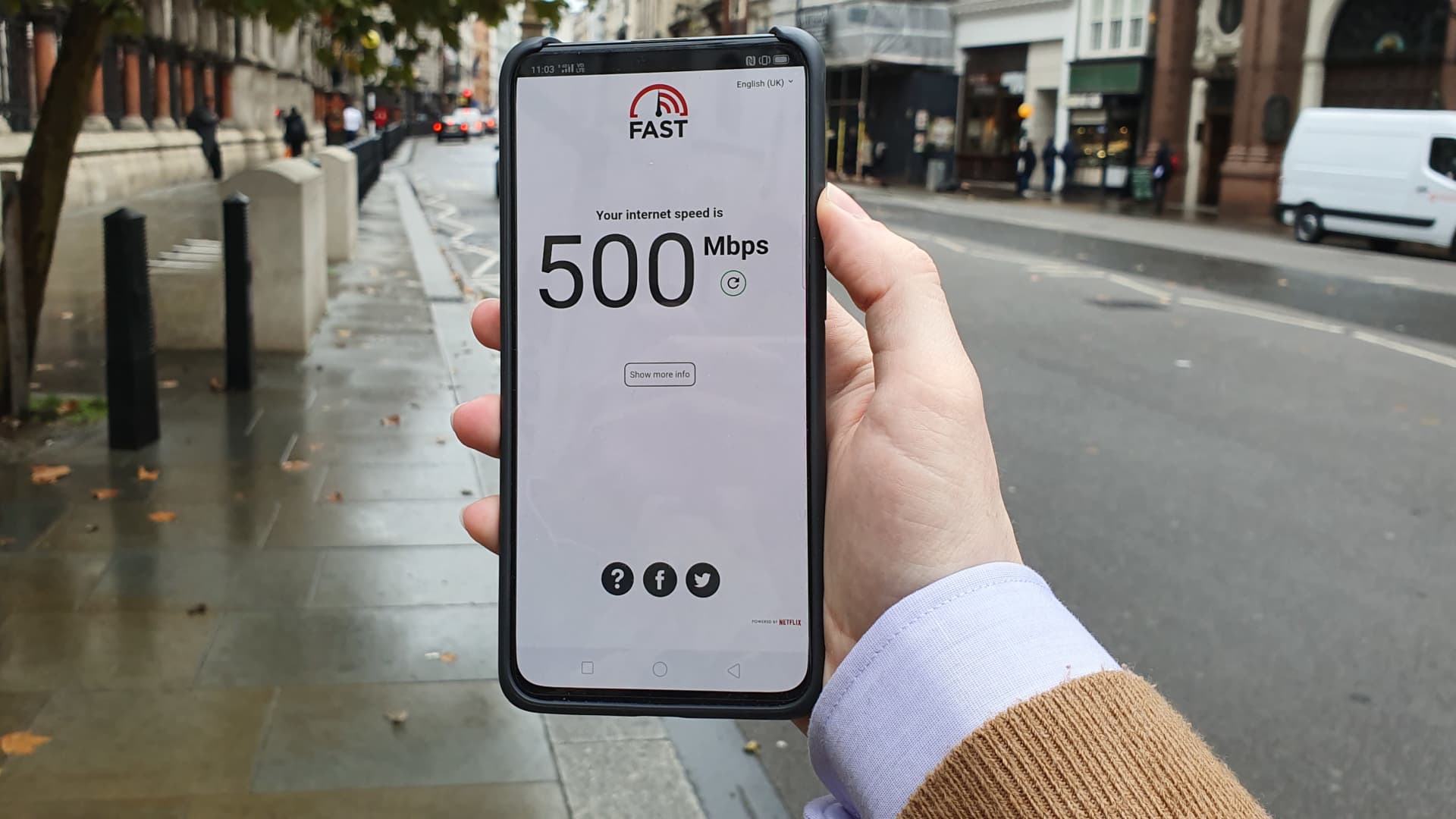
Testing out internet speeds on an Oppo Reno 5G smartphone with EE’s network.
Ryan Browne | CNBC
London falls far behind other major European cities when it comes to the quality of its 5G connection, according to a report shared with CNBC.
The findings from fixed and mobile network benchmarking firm MedUX found that London ranked 10th for 5G quality of experience in Europe, out of a group of 10 cities that includes Berlin, Barcelona, Paris, and Lisbon.
The German capital had the best 5G experience overall, which MedUX attributed to Berlin’s outperformance in areas like network consistency across different levels of applications and overall low latency.
“They are very good at doing things properly,” Rafael Galarreta, chief marketing officer of MedUX, told CNBC in an interview.
“They are the best in particular worlds,” he added, highlighting the city’s prowess in video streaming and data for over-the-top media platforms.
MedUX uses robots to quality assess fixed and mobile wireless internet broadband, identifying and resolving network issues. The company works with telecom providers, regulators, and enterprises to benchmark and monitor networks.
According to MedUX, Berlin has the best 5G coverage of any European city overall, according to MedUX, with a 89.6% reach. It is also the best city overall for 5G streaming, with average latency of less than 40 milliseconds.
Berlin, Barcelona, and Paris scored the highest among European cities on MedUX’s overarching 5G quality benchmark. Lisbon, Milan and Porto were the runners up.
London, on the other hand, was close to the bottom of the ranking for European 5G networks. According to MedUX, nearly 77.5% of the city’s population has 5G on their devices now, below the urban average.
London also performs badly on downlink speeds, with MedUX data showing the city gives users an average download speed of 143 megabits per second (Mbps), compared to 528 Mbps for Lisbon, 446 Mbps for Porto, 326 Mbps for Barcelona.
Munich in Germany, the second-worst city for 5G downlink speeds, had average download speeds of 259 Mbps.
“The U.K. is struggling for several reasons,” Galaretta said. “We already spoke about the macro things, but the two most important dimensions in which the U.K. mobile networks are lagging behind is speed and accessibility, and network responsiveness.”
Network responsiveness, Galaretta said, affects latency, which impacts data-intensive applications like online gaming — and in particular cloud gaming, which provides constant delivery of games to an end user through a remote data center.
Huawei ban to blame?
Figures shared by MedUX also show a clear picture of how British carriers are underperforming their European peers on 5G quality.
EE ranks 12th out of the top 36 carriers across European markets for 5G network quality of experience, data MedUX shared with CNBC shows. Vodafone ranks 24th, while Three is 33rd. O2 comes in at number 36. These companies and EE owner BT weren’t immediately available for comment when contacted by CNBC on Tuesday.
Galaretta highlighted the U.K.’s decision to ban Huawei from its 5G network as a possible reason behind the poor performance on 5G network quality.
The U.K. began rolling out 5G networks in 2019, as British carriers EE and Vodafone launched super fast data plans in the country for the first time.
It has faced struggles, after the U.K. government in the summer of 2020 announced Huawei would have to ban 5G equipment from its network completely by 2027. British carriers, which have heavily criticized the decision due to disruption to their rollouts, have been racing to dump Huawei gear in their core and non-core networks.
“This delayed deployment has likely affected overall coverage, availability, and user experience, particularly considering that the Huawei ban came after the initial rollout had already commenced,” Galaretta said.
Galaretta noted that quantifying the effects of the U.K.’s Huawei ban is a hard task, since MedUX’s research primarily focuses on measuring service quality and experience for end-customers.
Another factor at play, Galaretta noted, is the impact of industry mergers and acquisitions, along with the resulting pushback from regulators, which have led to disruptions to certain installations.
MedUX tests 5G quality across a number of different environments, including through radio technology samples and multi-thread download speed tests based on public content delivery networks.
It also takes into account the quality of usage of a range of different online services, including X, Facebook, YouTube streaming, the ease of accessing a certain URL, requests to gaming servers and navigating websites accessed through a Google Chrome browser.
Huawei competes with network infrastructure giants like Ericsson in Sweden and Nokia in Finland.
Despite Huawei’s ban from the U.K., the Chinese telecoms vendor still reportedly has a large presence in the country’s 5G network. According to a report from Strand Consulting, gear from Chinese vendors — among which Huawei is the only one active in Britain — still makes up some 41% of the U.K. 5G network.





